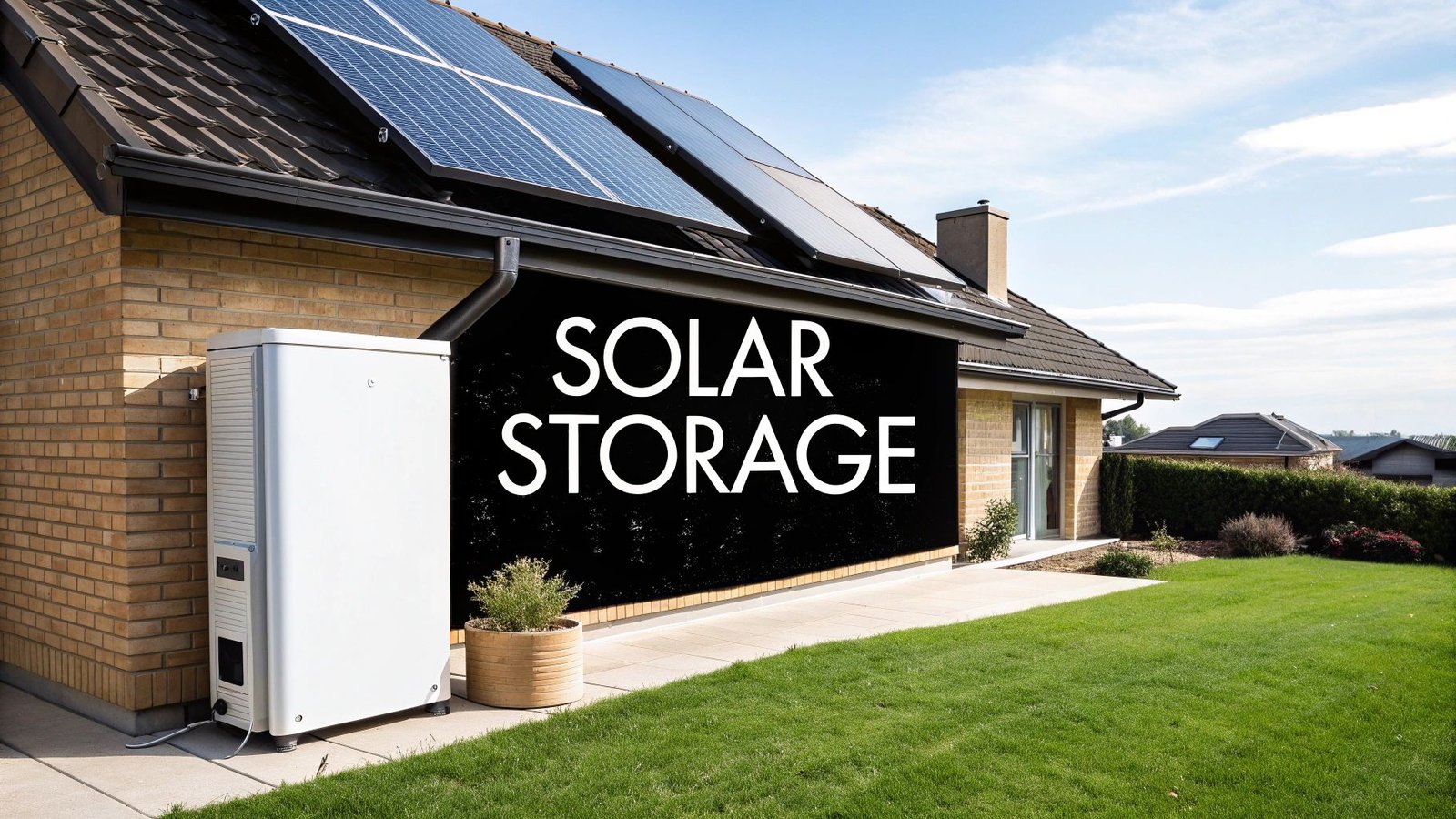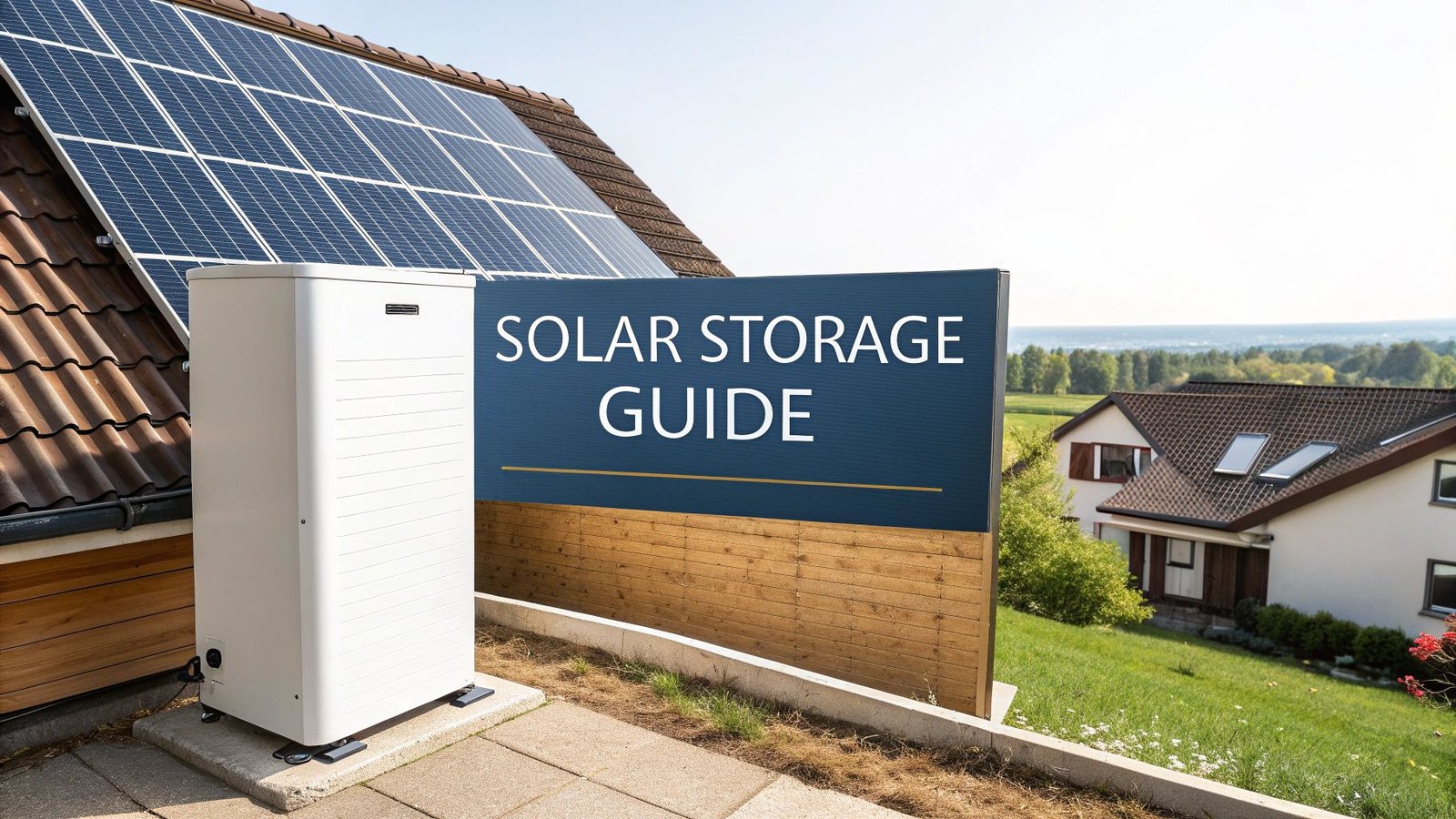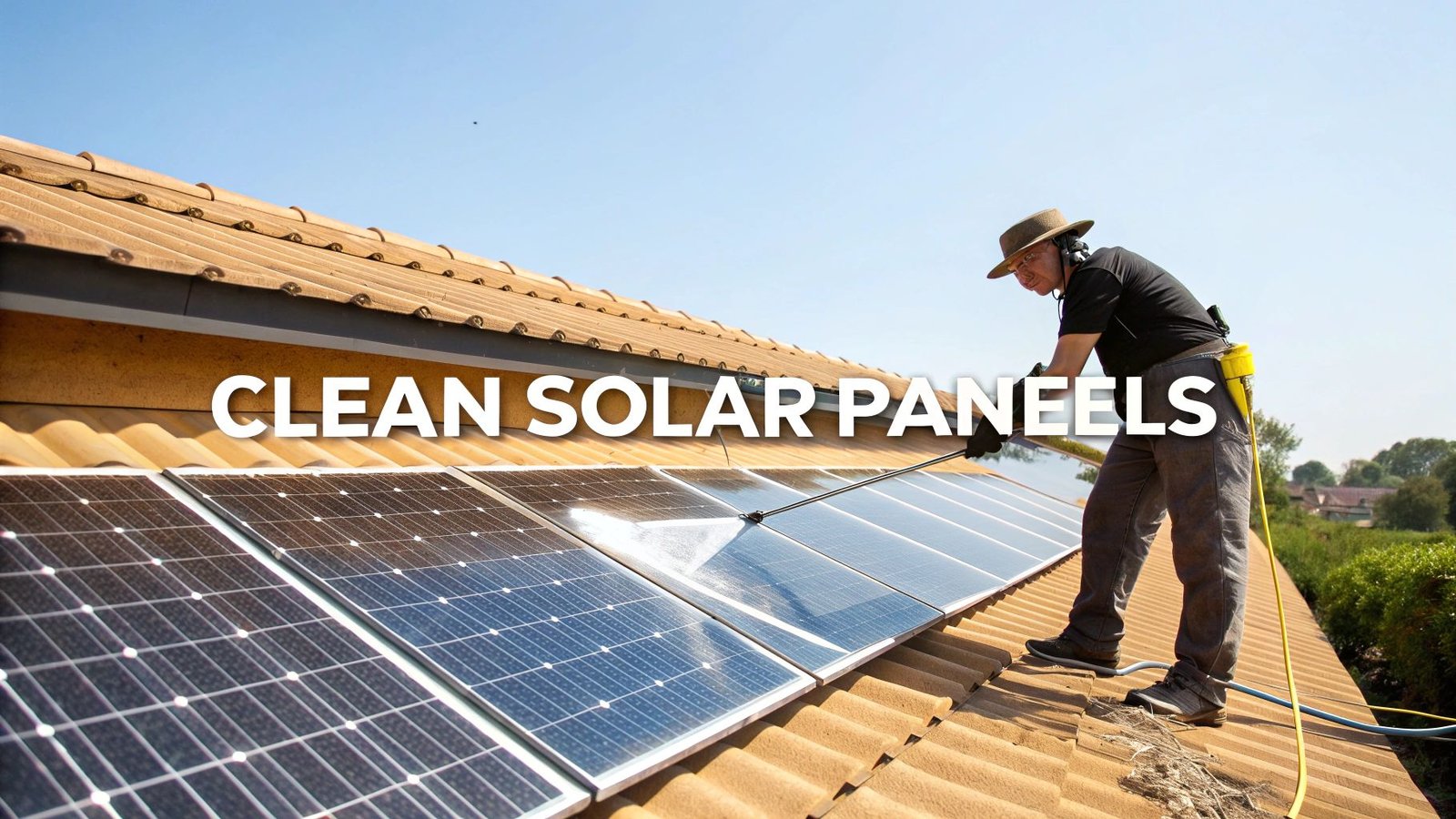Almacenar energía solar ya no es sólo un truco: se ha convertido en la clave para lograr una auténtica independencia energética. El concepto es muy sencillo: los paneles solares trabajan duro todo el día y un sistema de baterías captura la electricidad extra que generan. Esa energía almacenada la puedes utilizar cuando la necesites: por la noche, en días nublados o, lo que es más importante, cuando se corte la red.
Esta sencilla adición transforma su instalación solar de un generador de energía a tiempo parcial en una solución energética fiable y a tiempo completo para su hogar.
Por qué es imprescindible almacenar energía solar
Todos hemos visto paneles solares en los tejados, pero tienen una limitación evidente: sólo funcionan cuando hay sol. ¿Qué pasa con las más de 12 horas restantes del día? Aquí es donde el almacenamiento de energía cambia por completo las reglas del juego. Toma una fuente de energía impredecible y la convierte en un suministro fiable las 24 horas del día. Sin batería, sigues atado a la compañía eléctrica.
No se trata de una tendencia menor, sino de un cambio global masivo. A medida que las instalaciones solares se han disparado, la necesidad de almacenamiento ha crecido paralelamente. A finales de 2024, la capacidad solar acumulada en el mundo superará los 1.000 millones de euros. 2,2 teravatios (TW). Esto supone un enorme salto respecto a los 1,6 TW de 2023.
gráfico TD
A[Capacidad Solar Global 2023] -->|Aumentada en 600 GW| B(Capacidad Solar Global 2024);
A --- C(1,6 Teravatios);
B --- D(2,2 Teravatios);
style A fill:#f9f,stroke:#333,stroke-width:2px
style B fill:#f9f,stroke:#333,stroke-width:2px
estilo C fill:#ccf,stroke:#333,stroke-width:2px
estilo D fill:#ccf,stroke:#333,stroke-width:2px
Este crecimiento fue impulsado por más de 600 gigavatios (GW) de nuevos paneles solares instalados en un solo año. Toda esa nueva capacidad de generación crea una necesidad inmediata y acuciante de soluciones inteligentes de almacenamiento. Puede más información sobre esta expansión solar mundial y ver hasta qué punto está entrelazado con el auge del almacenamiento de energía.
Los beneficios reales del almacenamiento solar
¿Qué significa esto para usted en la práctica? Es mucho más que mantener las luces encendidas.
- Verdadera independencia energética: Cuando generas y almacenas tu propia energía, reduces drásticamente tu dependencia de la compañía eléctrica local y sus imprevisibles subidas de tarifas.
- Protección Blackout: Este es uno de los grandes. Una batería cargada actúa como un respaldo ininterrumpido, manteniendo tus elementos esenciales -frigorífico, luces, equipos médicos, Wi-Fi- funcionando sin problemas cuando falla la red.
- Gestión de costes más inteligente: Puede utilizar su propia energía solar almacenada durante las "horas punta", cuando la electricidad de la compañía eléctrica es más cara. Es una forma eficaz de protegerse de las tarifas más altas.
Piénselo de esta manera: el almacenamiento solar le hace pasar de ser un pagador pasivo de facturas a un gestor activo de su propio suministro eléctrico. Ya no eres un mero consumidor; tienes el control.
A medida que el apetito mundial por la electricidad sigue creciendo -alimentado por todo, desde nuevas viviendas a centros de datos-, tener su propia energía solar almacenada sólo será más valioso. Es el camino más claro hacia un futuro energético estable, asequible y resistente para su hogar.
Elegir la tecnología de baterías solares adecuada
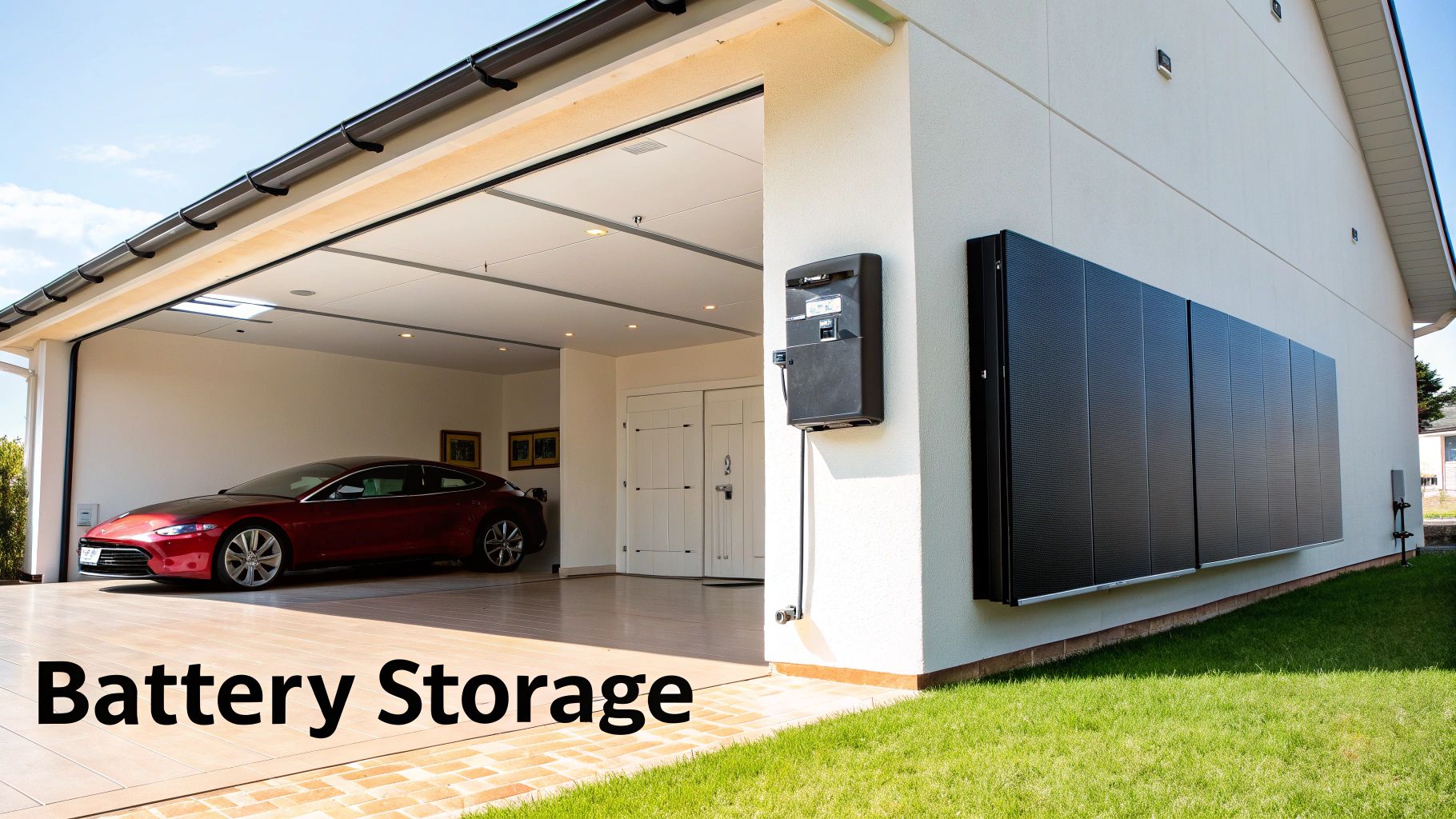
Así que has decidido almacenar tu propia energía solar. Ése es el primer gran paso. El siguiente, y posiblemente el más importante, es averiguar qué tipo de batería a utilizar. Si ha empezado a buscar, sabrá que el mercado está abarrotado, pero hay una tecnología que realmente ha tomado la delantera para hogares y empresas: ión-litio.
Hay una buena razón para su popularidad. Las baterías de iones de litio son potentes y ofrecen una fantástica combinación de larga vida útil, alta eficiencia y un tamaño sorprendentemente compacto. Esto ha impulsado una ola masiva de adopción.
Para ponerlo en perspectiva, el mercado mundial de almacenamiento de energía solar se valoró en 1.000 millones de euros. 93 400 millones de dólares en 2024 y se prevé que se dispare a 378.500 millones de dólares para 2034. Ese increíble crecimiento, impulsado tanto por los objetivos medioambientales como por la necesidad práctica de seguridad energética, está dominado de forma abrumadora por los sistemas de iones de litio. Puede profundizar en los datos del futuro del mercado del almacenamiento solar.
gráfico de barras
título Previsión del mercado mundial de almacenamiento solar
Eje x Año
eje y Valor del mercado (miles de millones de USD)
bar 2024, 2034
bar-data
93.4, 378.5
Para usted, este auge significa mejor tecnología, más opciones y precios más competitivos. Hablemos de lo que hay en el mercado.
Los principales tipos de pilas
Aunque las pilas de iones de litio son las favoritas, merece la pena conocer las otras opciones para entender por qué son las más recomendadas por la mayoría de la gente. Las dos principales alternativas son Fosfato de litio y hierro (que es un tipo específico y más seguro de litio-ion) y el mucho más antiguo y tradicional plomo-ácido baterías.
Elegir una batería es muy parecido a elegir un vehículo. Un deportivo biplaza es emocionante, pero inútil para una familia de cinco miembros. Un todoterreno tiene espacio, pero no consume tanto. La batería que elijas debe ajustarse perfectamente a tus objetivos, ya sea tener energía durante un apagón o ahorrar dinero en tu factura todos los días.
Desglosemos las diferencias reales entre las tecnologías de baterías más comunes en la actualidad.
Comparación de las principales tecnologías de baterías solares
Para tomar una decisión inteligente sobre cómo va a almacenar su energía solar, la mejor manera de ver los pros y los contras es compararlos. En la tabla siguiente se exponen las principales diferencias para ayudarle a determinar qué tecnología se ajusta a su presupuesto, sus necesidades de rendimiento y sus objetivos a largo plazo.
| Tipo de tecnología | Vida media (ciclos) | Eficiencia de ida y vuelta | Coste inicial | Caso de uso ideal |
|---|---|---|---|---|
| Fosfato de litio y hierro (LiFePO4) | 6,000 – 10,000+ | 95-98% | Alta | Uso diario y alimentación de reserva: Lo mejor para los hogares que desean un almacenamiento fiable y duradero para el ciclismo diario y la preparación para emergencias. |
| Níquel Manganeso Cobalto (NMC) | 2,000 – 4,000 | 90-95% | Alta | Aplicaciones de alta potencia: Son buenas para situaciones en las que se necesita mucha potencia rápidamente, como para grandes electrodomésticos, pero tienen una vida útil más corta que las LiFePO4. |
| Plomo-ácido | 500 – 1,500 | 80-85% | Bajo | Presupuesto Off-Grid: Adecuado para sistemas pequeños no conectados a la red donde el bajo coste inicial es la máxima prioridad y el mantenimiento regular es aceptable. |
Como puede ver, Fosfato de litio y hierro (LiFePO4) destacan como la opción superior para la gran mayoría de los propietarios de viviendas.
Su vida útil es excepcional, a menudo superior a 6.000 ciclos. En la práctica, eso significa que la batería puede durar 15 años o más, aunque la uses todos los días. Además, su eficacia de ida y vuelta es increíble, alcanzando hasta 98%. Esto garantiza que casi nada de su valiosa energía solar se pierda cuando la almacena y la utiliza más tarde.
Sí, el coste inicial es superior al de un sistema de plomo-ácido. Pero el valor a largo plazo es innegable. Usted está invirtiendo en un sistema más seguro, más eficiente y prácticamente libre de mantenimiento que alimentará su casa de forma fiable durante años. Esta es la razón por la que LiFePO4 se ha convertido en la recomendación para cualquiera que quiera maximizar su inversión en energía solar.
Cómo dimensionar correctamente su sistema de baterías solares
Dimensionar un sistema de baterías solares es una de esas cosas que hay que hacer bien. Es fácilmente el error más común -y más caro- que se comete al añadir almacenamiento de energía. Si es demasiado pequeño, se quedará a oscuras cuando más energía necesite. Si es demasiado grande, habrá malgastado miles de euros en una capacidad que nunca llegará a utilizar.
El punto óptimo no es una fórmula secreta; todo empieza con una sencilla auditoría energética de su propia casa.
Tu mejor amigo es la factura de la luz. Entre los detalles, encontrará el consumo medio diario de electricidad, que suele indicarse en kilovatios-hora (kWh). Esta cifra es la base de todo el proyecto. Es una instantánea real de la cantidad de energía que consume tu hogar cada día.
Eche un vistazo a esta factura: le muestra exactamente dónde encontrar esa cifra crucial de kWh diarios. Esta es tu línea de salida.
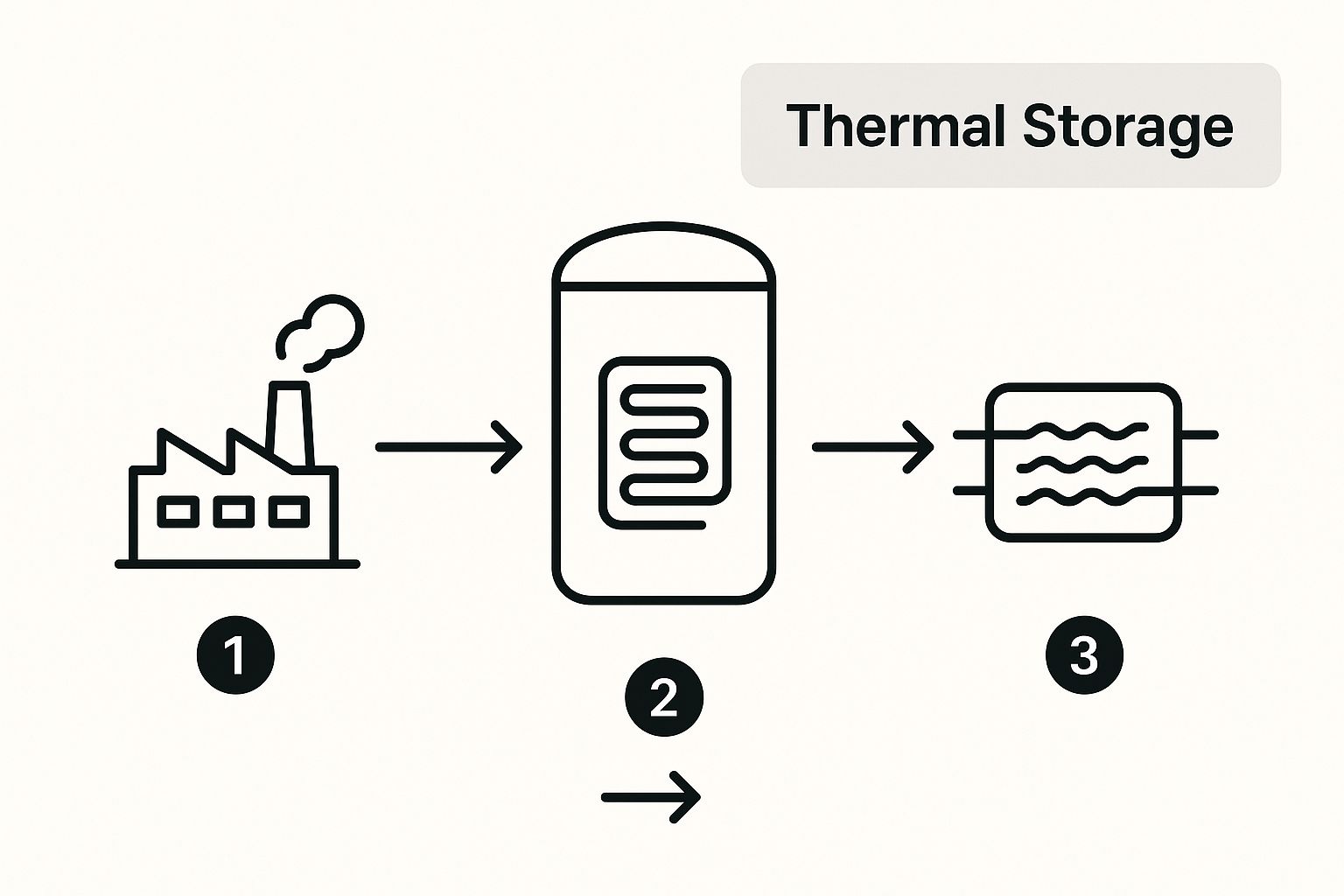
Una vez que tengas esa cifra, podrás calcular tu consumo energético de referencia, que te dirá exactamente cuánto almacenamiento necesitarías para que todo siguiera funcionando con normalidad durante un apagón.
En primer lugar, ¿cuál es su principal objetivo de almacenamiento?
Conocer su uso diario es la mitad de la batalla. La otra mitad es decidir lo que realmente quieres que tu batería do. Tu respuesta tendrá un impacto enorme en el tamaño y el coste del sistema.
¿Cuál es el objetivo principal?
- Energía de reserva esencial: ¿El objetivo es mantener las luces encendidas y los aparatos críticos en funcionamiento durante un apagón? Piensa en el frigorífico, el router de Internet, algunas luces y quizá algún aparato médico. Esta es la opción más popular, ya que requiere una batería más pequeña y asequible.
- Copia de seguridad para toda la casa: ¿O prefiere una transición sin fisuras, alimentando su todo ¿como si la red no se hubiera caído nunca? Esto es absolutamente factible, pero exige una inversión mucho mayor y más significativa.
- Autoconsumo máximo: Puede que tu prioridad no sean los apagones. Sólo quieres utilizar la mayor cantidad posible de tu propia energía solar y reducir drásticamente la factura de la luz. Este objetivo suele situarse en algún punto intermedio, con un sistema dimensionado para cubrir tus necesidades energéticas de sol a sol.
Un consejo profesional sobre el terreno: Como regla general, procure disponer de al menos un día completo de autonomía en función de su objetivo. Por ejemplo, si tus electrodomésticos esenciales suman 10 kWh al día, un 10-13 kWh es un punto de partida fantástico. Esa capacidad extra te proporciona un cómodo colchón para los días nublados o cuando usas más energía de la prevista.
Ejemplos reales de dimensionamiento
Pongamos esto en práctica y veamos cómo los diferentes objetivos cambian las cifras finales.
Imagina un Casa suburbana de 2.000 pies cuadrados que utiliza unos 30 kWh de electricidad al día. La prioridad del propietario es la reserva esencial. Quieren alimentar el frigorífico (2 kWh/día), luces (1 kWh/día), y electrónica doméstica (2 kWh/día). Es decir, un total de 5 kWh de uso diario crítico. En este caso, un único 10 kWh proporcionaría casi dos días completos de energía para lo esencial.
Ahora, cambiemos de marcha a un pequeño taller comercial que consume alrededor de 50 kWh al día. Su principal objetivo es económico: evitar las elevadísimas tarifas de la compañía eléctrica por los picos de consumo, que se producen entre las 16.00 y las 21.00 horas. Si sus datos muestran que utilizan 20 kWh durante esa costosa ventana, necesitan una batería construida específicamente para compensar ese uso. A 20-25 kWh les permitiría utilizar la energía solar almacenada cuando la electricidad de la red es más cara.
Si tiene una idea clara de su uso diario y define su objetivo principal, podrá trabajar con un instalador cualificado como Energía radiante para diseñar un sistema que encaje a la perfección. De este modo, no solo comprará una batería, sino que invertirá en una solución que le aportará un valor real durante muchos años.
Comprender el proceso de instalación
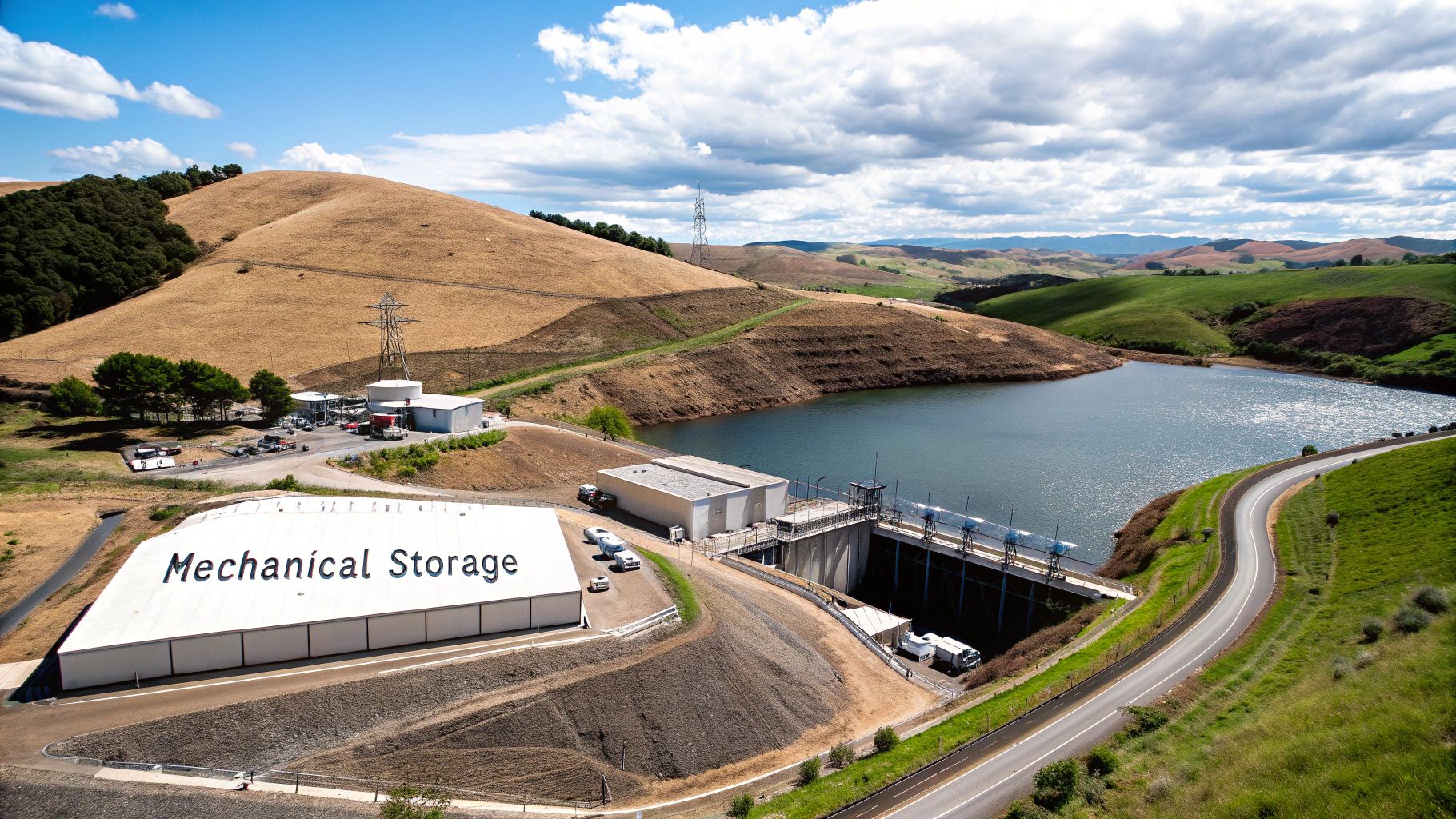
Saber qué esperar el día de la instalación puede convertir lo que parece un gran proyecto de construcción en la emocionante mejora del hogar que realmente es. Esto no es un tutorial de bricolaje, sino una mirada entre bastidores a una instalación profesional. Mi objetivo es dotarle de los conocimientos necesarios para entender el proceso y hacer las preguntas adecuadas.
Cuando los profesionales se pongan manos a la obra, verá cómo se instalan algunas piezas clave del equipo. La más obvia es la propia unidad de baterías, el núcleo de su nuevo sistema de almacenamiento. Pero también verá inversor. Se trata de una pieza no negociable del rompecabezas que convierte la corriente continua de los paneles y la batería en la corriente alterna con la que funciona su hogar.
Otro componente crítico es el regulador de carga. Piense en él como un guardián inteligente para su batería. Gestiona cuidadosamente la electricidad que fluye desde los paneles solares, evitando la sobrecarga y protegiendo su inversión al prolongar la vida útil de la batería. Todas estas piezas funcionan conjuntamente, creando un sistema inteligente que sabe exactamente cuándo almacenar energía y cuándo suministrarla.
Acoplamiento de CA frente a acoplamiento de CC: ¿Cuál es la diferencia?
Es casi seguro que su instalador le hablará de "acoplamiento de CA" y "acoplamiento de CC". Se trata de dos formas distintas de conectar una batería a la instalación solar, y la elección tiene consecuencias reales en cuanto a eficiencia, coste y complejidad.
- Sistemas acoplados de CA: Este es el método habitual para añadir una batería a un existente de paneles solares. La batería se conecta básicamente al cuadro eléctrico principal de la casa. Es una adaptación mucho más sencilla porque el instalador no tiene que volver a cablear la instalación solar original.
- Sistemas acoplados de CC: Si va a instalar energía solar y almacenamiento en la mismo tiempoEsta suele ser la ruta más eficiente. En este caso, los paneles, la batería y el inversor se conectan juntos en el lado de CC del sistema. Esto significa que la energía sólo se convierte de CC a CA una vez, lo que reduce la pérdida de energía.
gráfico TD
subgrafo "Sistema acoplado en CC (nuevas instalaciones)"
dirección LR
A[Paneles Solares (CC)] --> B{Inversor};
C[Batería (CC)] --> B;
B --> D[Hogar (CA)];
fin
subgrama "Sistema acoplado de CA (retroadaptaciones)"
dirección LR
E[Paneles solares (CC)] --> F{Inversor solar};
F --> G[Hogar (CA)];
H[Batería (CC)] --> I{Inversor de batería};
I --> G;
fin
Una simple analogía puede ayudar. El acoplamiento de CA es como añadir una terraza acristalada terminada a la casa: se conecta a la estructura principal, pero es en gran medida su propio sistema. El acoplamiento de CC es como diseñar esa terraza acristalada en los planos originales desde el primer día para conseguir una mayor integración. Ninguno de los dos es universalmente "mejor", pero la elección correcta depende casi siempre de si se trata de una reforma o de empezar de cero.
Qué esperar del equipo de instalación
Una instalación profesional es mucho más que conectar cables. Es un proceso cuidadosamente gestionado que garantiza la seguridad, el cumplimiento de las normas y el máximo rendimiento durante décadas. De hecho, la rapidez de una instalación profesional es una gran ventaja. Una central eléctrica tradicional tarda años en construirse, pero un sistema residencial de energía solar más almacenamiento puede ponerse en marcha en tan sólo unos meses. un díapara una seguridad energética casi instantánea.
Su equipo de instalación se encarga de todo, desde la obtención de los permisos locales necesarios hasta la puesta en marcha final del sistema. Por eso, elegir a un socio de confianza, como Energía radiantees crucial: ellos gestionan los quebraderos de cabeza para que tú no tengas que hacerlo.
Cuando llegue el equipo, se pondrán manos a la obra para montar la batería y el inversor, tender el conducto que protege el cableado e integrar los nuevos componentes en el cuadro eléctrico principal de tu casa. Cuando todo esté conectado, encenderán el sistema y le mostrarán la aplicación de supervisión. Este último paso es clave, ya que le muestra exactamente cómo realizar un seguimiento del rendimiento de su sistema y garantiza que se sienta seguro gestionando su propia energía desde el momento en que se marchan.
Mantenga su sistema en plena forma durante años
Ha hecho una inversión importante en su batería solar y, como cualquier equipo de alto rendimiento, necesita un poco de atención para que siga funcionando sin problemas. La buena noticia es que los sistemas de baterías modernos están diseñados para no tener que intervenir. Aún así, ser proactivo es la clave para maximizar su vida útil y obtener el mejor rendimiento posible.
El factor que más influye en la salud de una batería es el lugar donde se encuentra. El calor y el frío extremos son enemigos de las celdas de la batería, ya que hacen que se degraden mucho más rápido. Precisamente por eso, un instalador profesional insistirá en colocar la batería en un lugar protegido y con un clima estable, como un garaje o un sótano, nunca bajo la luz directa del sol ni expuesta a la intemperie.
No pierdas de vista nada con tu aplicación de vigilancia
Cuando se instaló su sistema, debería haber sido configurado con una aplicación de monitorización. Considérela como el cuadro de mandos de su central eléctrica personal. Es su mejor herramienta para saber cómo almacena y utiliza la energía solar cada día. Siempre les digo a mis clientes que se acostumbren a comprobarlo de vez en cuando.
No es necesario que te obsesiones con ello, pero no pierdas de vista algunas cifras clave:
- Estado de carga (SoC): Es un término elegante para referirse al indicador de combustible de la batería.
- Flujo de energía: La aplicación te permite ver de dónde viene la energía (de tus paneles o de la red) y hacia dónde se dirige (a tu casa, a la batería o de vuelta a la red).
- Rendimiento diario: Es ideal para ver cuánta energía solar has generado, cuánta has almacenado y cuánta has utilizado.
Una comprobación visual rápida una vez al mes también es un buen hábito. Acércate a la unidad de la batería. ¿Están bien apretadas las conexiones? ¿Hay alguna luz de advertencia extraña? ¿Está limpia y despejada la zona que la rodea? Esta revisión de cinco minutos puede ayudarle a detectar un pequeño problema antes de que se convierta en uno real.
Hábitos sencillos para alargar la vida de la batería
Si quieres sacarle el máximo partido a tu batería, evita dejarla descargada todo el tiempo. Tu sistema es inteligente: la mayoría de las baterías modernas de iones de litio llevan incorporado un Profundidad de descarga (DoD) límite que les impide llegar al cero real, lo que es una gran salvaguarda. Aun así, llevarlo constantemente al mínimo absoluto añade estrés. Lo mejor es dejar que el software del sistema haga su trabajo y gestione los niveles de carga por ti.
Cuidar la batería no es sólo proteger el hardware: también contribuye a garantizar la estabilidad de la red eléctrica. Estamos viendo cómo esto ocurre a gran escala en todo el país. Sólo en el primer trimestre de 2025, EE.UU. encendió un número récord de 2 gigavatios (GW) de nuevo almacenamiento de energía. Este auge es crucial para equilibrar la red a medida que se conecta más energía solar, ayudando en todo, desde la regulación de la frecuencia hasta la reducción de la tensión durante los picos de demanda. Más información Crece el almacenamiento de energía en EE.UU. y construir una red eléctrica más resistente para todos.
Respuestas a sus preguntas sobre almacenamiento solar
Cuando se empieza a explorar el almacenamiento solar, surgen muchas preguntas. Es una decisión importante, y obtener respuestas claras y directas es el primer paso para realizar una inversión inteligente. Estas son algunas de las preguntas más frecuentes que nos hacen los propietarios de viviendas que acaban de iniciar su andadura en la energía solar.
¿Cuánto dura realmente una batería solar?
Es una gran pregunta, porque va directa al corazón del valor del sistema. Un sistema Fosfato de litio y hierro (LiFePO4) es un verdadero caballo de batalla. Puedes esperar que venga con una 10 años garantía, pero no es raro que sigan funcionando bien durante 15 años o más con los cuidados adecuados.
La vida útil se mide en "ciclos de carga", y una batería LiFePO4 de calidad suele tener una capacidad nominal de De 6.000 a 10.000 ciclos completos. Piense en ello como en el kilometraje de un coche. El uso que hagas de ella es importante: si evitas vaciarla con frecuencia y la mantienes alejada de temperaturas extremas, conseguirás mucho. Se trata de un salto enorme con respecto a la antigua tecnología de plomo-ácido, que a menudo había que sustituir cada 3-5 años.
¿Puedo añadir una batería a mis paneles solares actuales?
Por supuesto. Es una de las mejoras más comunes que vemos. Si ya tiene paneles solares en el tejado, añadir una batería es una forma fantástica de sacar más partido a su inversión inicial. Este proceso se suele llamar "retroadaptación".
La forma más popular de hacerlo es con un Batería acoplada a CA. Este tipo de batería se conecta al panel eléctrico principal de su casa en lugar de directamente al panel solar. La mayor ventaja en este caso es la simplicidad; significa que no tenemos que tocar el cableado solar existente, por lo que la instalación es mucho más sencilla y menos invasiva. Simplemente se integra en el flujo de energía de su casa, listo para proporcionar energía de reserva.
¿Cuál es el coste real de un sistema de baterías solares?
El precio final depende de dos factores: la capacidad de almacenamiento (medida en kilovatios hora o kWh) y la marca elegida. Para una vivienda típica que necesite una alimentación de reserva sólida, un sistema de baterías de iones de litio instalado por un profesional suele costar entre 1.000 y 1.000 euros. $8.000 y $20.000.
Obviamente, se trata de una compra importante, pero ayuda pensar en ella como una mejora de la vivienda a largo plazo. No olvide informarse sobre los créditos fiscales federales, las rebajas estatales y los incentivos locales, ya que pueden reducir drásticamente el coste inicial. A lo largo de su vida útil, la batería se amortiza reduciendo la factura de la luz y con la inestimable seguridad de disponer de electricidad en caso de apagón.
¿Es realista la autonomía total?
Desconectarse completamente de la red es el sueño de muchos, y técnicamente es posible. Sin embargo, es una empresa mucho más grande que un sistema estándar conectado a la red y requiere un compromiso real con un estilo de vida consciente de la energía.
Para cortar de verdad el cordón, tu sistema tiene que estar muy sobredimensionado. Necesitarás:
- Un enorme campo solar que puede generar electricidad más que suficiente para su hogar, incluso en días nublados en pleno invierno.
- Un banco de baterías muy grande con capacidad suficiente para aguantar varios días de mal tiempo sin sol.
Esto supone un coste inicial mucho mayor que el de un sistema diseñado para energía de reserva. Para la mayoría de la gente, seguir conectado a la red y utilizar una batería como respaldo y ahorro diario es el equilibrio perfecto entre independencia, fiabilidad y coste. La vida sin conexión a la red tiene más sentido en propiedades remotas en las que no hay conexión a la red o cuya instalación costaría una fortuna.
¿Está preparado para tomar el control de su energía y conseguir una verdadera independencia energética? El equipo de Energía radiante se especializa en el diseño y la instalación de soluciones solares y de almacenamiento de alta calidad que se adaptan perfectamente a las necesidades únicas de su hogar. Nos encargamos de todos los pasos, desde el diseño inicial hasta la puesta en marcha final, para garantizarle un sistema fiable que ofrezca valor durante décadas. Visite Radiant Energy hoy mismo para obtener su análisis solar personalizado.

